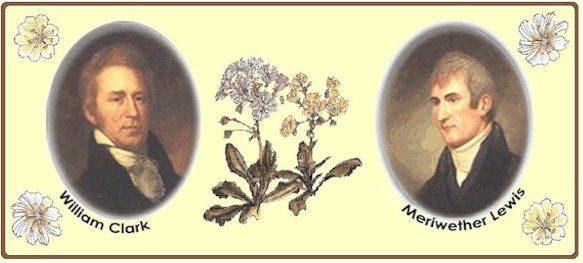WALLACE W HANSEN
Native Plants of the Northwest
Native Plant Nursery & Gardens
2158 Bower Ct S.E., Salem, Oregon 97301 E-Mail:
Wallace W Hansen
PHONE (503)581-2638 FAX(503)581-9957

WALLACE W HANSENNative Plants of the NorthwestNative Plant Nursery & Gardens2158 Bower Ct S.E., Salem, Oregon 97301 E-Mail:
Wallace W Hansen |

|
| For information about Wallace W Hansen Northwest Native Plant Nursery & Gardens: Business Information (Ordering, etc.) | |
Updated January 31, 2003 |
Wallace Hansen Celebrates Lewis and Clark |
|
|
 
 |
|
At this time in 1806, Expedition members are enjoying their warm houses and the Northwest winter in their camp at Fort Clatsop. They are not idle, though. Captain Lewis is scouting the area for plants (he found around 50 in this area!) and documenting his discoveries. Captain Clark uses the time to catch up on his cartography:
Native People continue to visit the Captains and the Corps. A note Captain Clark made after a December visit:
We'll use our time until next week's edition to prepare a list of all the plants Captain Lewis found at Fort Clatsop. |
|
|
|
|
|
Botanical Discoveries: Blue Elderberry (Sambucus cerulea) Fort Clatsop, Oregon, February 2, 1806 We don't know what attracted Captain Lewis to the Blue Elderberry. It is a handsome, deciduous shrub, with its multiple stems, reaches 6-12.’ A little later in the year, the leaves would appear followed by the flowers and then the berries. But logic indicates the good Captain was introduced to Sambucus cerulea by his native visitors who value it highly. Very similar to it's sister, the Red Elderberry, the Blue and Red shrubs are used in the same ways. In her website titled Native American Indian: Art, Culture, Education, History, Science (www.kstrom.net/isk/), Paula Giese gives us uses for the Red Elderberry, sister of Blue. She says: "There is a name for the tree, for the flowers for tea, for the flowers just to cook, and 3 names for the berries. not-ripe, ready (raw) and dried. This tree flowers in July, big bunches of sweetish white flowers. You can easily pick them by the stems of bunches (they make a better tea if taken when fresh, before the berries set). Fresh elder flowers can be fried into breakfast or dessert fritters. Batter:
Heat fat to medium, 375°. Remove the coarse stems from flower clusters, but keep the small ones to hold it together. Dip cluster into batter whole, fry for about 4 minutes till golden, squeeze orange juice over them while still hot, roll in granulated white sugar. Keep warm in an oven on paper towels until all are done. Eat them by picking up, discard the "bones" (stems). Kids especially love to do this." |
|
|
Of Original People's philosophy about the shrub, Paula says that elder is a woman's plant and men or boys should not pick the flowers. This is because Elderberry is used for physical problems of women. So if you're female and need "medicine," find your tree this way: Go to the elderberry shrubs and walk around them until you feel attracted to one. This will be "ogimauikwe," the headwoman tree for the group. Talk to her about your troubles and leave some tobacco (kinnikinnik) for her as a sign of respect. When the flowers bloom, come back to her and talk again about the problem. Do not pick anything from her, but gather flowers from sister trees in the group. Paula cautions not to tell men or boys anything about Elderberries. Native peoples are very circumspect in discussing "women's" or "men's" personal issues and this is "women's medicine." |
|
|
Current events:
February 6, 20, 27, 2003
Technology Workshop for Teachers: The Lewis and Clark Rediscovery Project
Highlands Middle School, Kennewick, WA Pre-registration is required. Classes are limited to 20 participants. For more information, call (509) 585-3471.
December 7, 2002 - June 15, 2003 "Time Not Wasted -- Winter with the Corps" Exhibit Lewis and Clark National Trail Interpretive Center Great Falls, MT The exhibit portrays the winter encampments of the Lewis and Clark Expedition and how each encampment uniquely met more than the basic needs of survival – due to the natural surroundings and the objectives at the three different locations: Fort Dubois, Fort Mandan, and Fort Clatsop. The Center’s winter hours are Tuesday through Saturday, 9 a.m. to 5 p.m.; and Sunday, noon to 5 p.m.; the Center is closed Mondays during the winter. For more information about the Center and its programs, call (406) 727-8733 or visit www.fs.fed.us/r1/lewisclark/lcic.htm on the Internet. The Center is managed by the USDA Forest Service. |
|
Back Issues:
To see back issues of Wallace Hansen Celebrates Lewis and Clark, click on this link to jump to the index. |
|
The illustrated map below was created by renowned botanical artist Heidi D. Hansen especially for this website. Done in ink and watercolors, Heidi shows many of the plants Captain Lewis documented overlaid atop a map showing a portion of the journey. (Click on image for large view). |
|
|
|
|
|
|
|
|
|
Click here to return to my Home Page |
|
Questions about plants, click here: Regular Email to Wally To order, click here: Secure Email to Wally |
|
|
Comments or questions about our web site, click here: Webmaster |